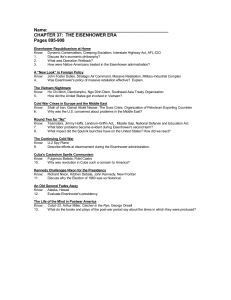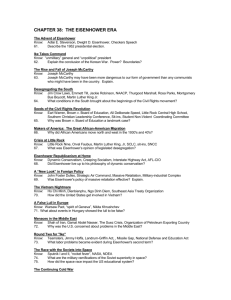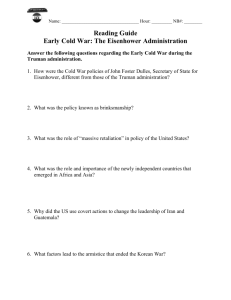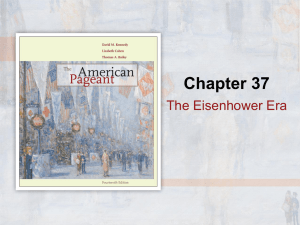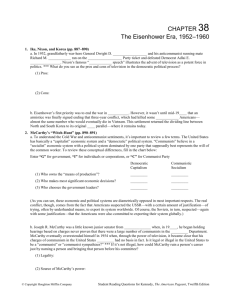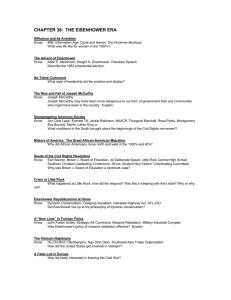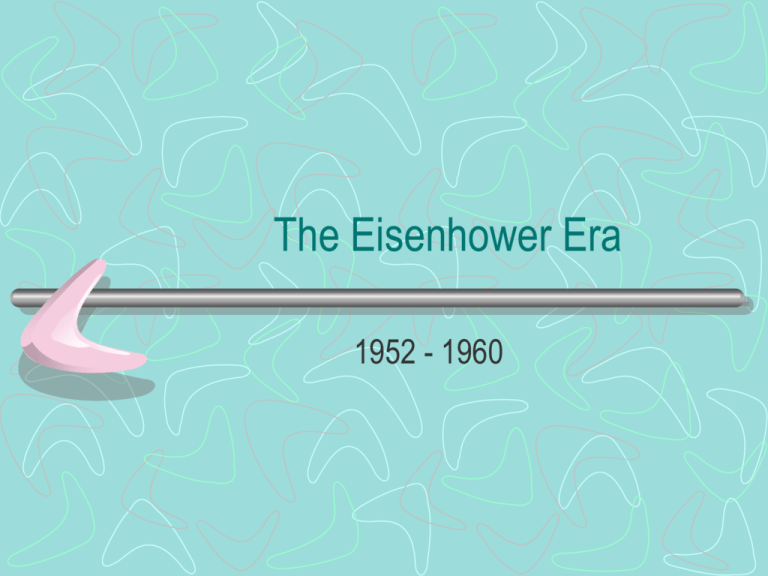
The Eisenhower Era
1952 - 1960
Election of 1952
• Dem – Adlai E. Stevenson
• Rep – Dwight D. Eisenhower
• Running mate – Richard Nixon
• Richard Nixon did most of the campaigning
• Nixon was accused of corruption
– “Checkers speech” on national TV – gained support
• Demonstrated the impact of TV on politics
Nixon and Eisenhower at the 1952 Republican Convention
Nixon and Eisenhower at the 1952 Republican Convention
In this picture, the triumphant Republican nominees for the White House pose with
smiles and wives--Pat Nixon and Mamie Eisenhower. Seen as a statesman and not a
politician during the campaign, Eisenhower worked hard to ensure his nomination
over Robert Taft, and then chose Richard Nixon to balance the ticket because he was
a younger man, a westerner, and a conservative. (UPI Bettmann Archives)
Copyright © Houghton Mifflin Company. All rights reserved.
“I Like Ike”
• Eisenhower wins easily
– Promised to go personally to Korea to end the war
– Dec 1952 – Eisenhower went to Korea
• 7 months later, after threatening to use atomic weapons,
an armistice was finally signed (repeatedly violated)
• 1953 – Korea War ended
– Bought only a return to the conditions of 1950
• Korea remained divided at the 38th parallel
Eisenhower happy
Eisenhower happy
Like a benign grandfather, Dwight D. Eisenhower provided a reassuring presence in the
White House in the 1950s. His moderation, balanced judgment, and apparent aloofness
from partisanship appealed to as many as did his fondness for bridge and poker,
bourbon, fishing and hunting, and golf. (Courtesy Dwight D. Eisenhower Library)
Copyright © Houghton Mifflin Company. All rights reserved.
Problems for African Americans
• Jim Crow Laws – separate social arrangements for
blacks & whites
– Schools, public toilets, drinking fountains, waiting rooms
• Violence broke out
– 14-year old Emmett Till was lynched in 1955 for leering at a
white woman
• 1944 – An American Dilemma by Gunnar Mydral
– Exposed the contradiction between the treatment of blacks
and the belief that all men are created equal
• Jackie Robinson – 1st AA to break the racial barrier in
sports
Jackie Robinson baseball promotional booklet
Jackie Robinson baseball promotional
booklet
Jackie Robinson broke the color barrier
in major league baseball in 1947, when
he joined the Brooklyn Dodgers. After
serving as a lieutenant in the army
during the war, Robinson, an AllAmerican in football and baseball at
UCLA, played with the Kansas City
Monarchs of the Negro American
Baseball League until he was signed by
the Dodgers in 1945. Moved from the
minors to the majors in 1947, he earned
"Rookie of the Year" honors and later
was inducted into the Baseball Hall of
Fame. (Collection of Michael
Barson/Past Perfect)
Copyright © Houghton Mifflin Company. All rights reserved.
Drink Coca Cola--White Customers Only!
Drink Coca Cola--White Customers
Only!
Signs like this were common in the
South prior to the Civil Rights
Movement of the 1960s. (Library of
Congress)
Copyright © Houghton Mifflin Company. All rights reserved.
Desegregating the South
• African Americans started demanding more rights after
WWII
• 1944 – Supreme Court ruled that the “white primary”
was unconstitutional
• Sweatt v. Painter – separate professional schools for
black were not equal
– Thurgood Marshall, future Supreme Court Justice
• Dec 1955 – Rosa Parks was arrested & started the
Montgomery bus boycott
• Martin Luther King Jr. followed the principles of Gandhi
– Nonviolent protest
Seeds of Civil Rights Revolution
• 1948 – Truman ended segregation in the military
– Congress still resisted passing civil rights legislation
– Eisenhower showed no real signs of interest in the racial
issue
• Chief Justice Earl Warren – attacked social taboo items
– Brown v. The Board of Education of Topeka, Kansas (1954)
• Ruled that segregation was unequal & unconstitutional
• Reversed Plessy v. Ferguson (1896) – separate but equal
doctrine
• Desegregation with “all deliberate speed”
Ike is Forced to Act
• Sept 1957 – Little Rock, Arkansas
– Governor Orval Faubus organized the National Guard to
prevent 9 black students from enrolling in Central High
School
– Eisenhower was forced to send troops to escort the students
to class
• 1957 – Congress passed the Civil Rights Act
– Set up a Civil Rights Commission to investigate violations of
civil rights & authorized federal injunctions to protect voting
rights
Little Rock--white student yelling at Elizabeth Eckford, September 4, 1957
Little Rock--white student yelling at Elizabeth Eckford, September 4, 1957
Elizabeth Eckford, age 15, one of the nine black students to desegregate Central
High School, endures abuse on her way to school. Forty years later, the young white
woman shouting insults asked for forgiveness. (Wide World)
Copyright © Houghton Mifflin Company. All rights reserved.
The Movement Starts
• 1957 – Martin Luther King Jr. formed the Southern
Christian Leadership Conference (SCLC)
– Aimed to mobilize the power of black churches
• Feb 1, 1960 – “sit-in” movement
– 4 black college students in Greensboro, NC started a sit-in at
Woolworth’s lunch counter
– Movement spread very quickly across the South
• April 1960 – SNCC is formed
– Student Non-Violent Coordinating Committee
Sit-in--Jackson, Mississippi, May 28, 1963
Sit-in--Jackson, Mississippi, May 28, 1963
The sit-ins of 1960 initiated the student phase of the civil-rights movement. Across the
south, young black activists challenged segregation by staging nonviolent
demonstrations to demand access to public facilities. Their courage and commitment
reinvigorated the movement, leading to still greater grass-roots activism. (World Wide)
Copyright © Houghton Mifflin Company. All rights reserved.
Eisenhower’s Domestic Policy
• New Republicanism
– Strove to balance the federal budget & guard against
“creeping socialism”
– Extended Social Security benefits & raised minimum wage
– Launched the largest public works program ever
• Highway Act – created interstates
– Failed to solve the economic problems of the 1950’s: low
farm prices
• Operation Wetback (1954) – sent 1 million Mexicans
back
• Sought to cancel the Indian New Deal
Indian boy protesting, April 18, 1958
Indian boy protesting, April 18, 1958
One of Eisenhower's goals was to reduce
federal spending and controls. In line
with this policy, he tried to turn Indian
affairs over to the states and liquidate
federal services and reservations.
Between 1954 and 1960, sixty-one tribes
were affected. This picture shows a 4year-old Tuscarora boy protesting state
and federal policies that attacked Indian
rights. (Wide World Photos, Inc.)
Copyright © Houghton Mifflin Company. All rights reserved.
Eisenhower’s Foreign Policy
• Sec of State John Dulles
– Pledged to “roll back” communism & “liberate captive
peoples”
– Wanted to build up a air fleet of superbombers carrying
nuclear bombs (Strategic Air Command or SAC)
– Massive retaliation policy – you attack us we will attack you
Girl in front of dome atomic bomb shelter
Girl in front of dome atomic bomb shelter
As the Cold War intensified and the Soviets became a nuclear power, the government
began to consider methods to survive a nuclear war. One "solution" was to encourage
people to build backyard bomb shelters. Pictured here is one family's atomic bomb
shelter that slept six. The cost was $1,250 in 1951. (Corbis-Bettmann)
Copyright © Houghton Mifflin Company. All rights reserved.
The Vietnam Nightmare
• 1954 – US was financing 80% of the French colonial
war in Indochina at $1 billion/year
• March 1954 – Dien Bien Phu
– 25,000 French troops were trapped at this French base
– Pleaded with the US for assistance but Ike refused
• 1954 – Geneva Accords
– Communist & Democratic powers agree to divide Vietnam
• Ho Chi Minh’s Communist would control the north
• Non-communist forces supported by the US would control the South
• 1956 – Vietnam would unify after national elections
SEATO
• 1954 - Sec Dulles helped start the Southeast Asia
Treaty Organization (SEATO)
– Included US, Great Britain, France, & others
– Nations pledged joint action against any aggressor
Cold War Thaws
• Nikita Khrushchev
– Becomes leader of USSR when Stalin dies
– Hope for better relationship with USSR arises
– Soviets agreed to end their occupation of Austria // ends with
Hungarian Revolution in 1956
• July 1955 – Geneva Summit
– Policy of peaceful coexistence emerges
Menaces in the Middle East
• CIA engineered a political coup
– 1953 – Installed a youthful Shah of Iran as a pro-western dictator who
guaranteed Iranian oil for the West
• Us intervention led to a legacy of resentment
• Suez Crisis – 1956
– Egyptian leader, Nasser, nationalized the Suez Canal owned chiefly by British
& French stockholders
– led to a joint British-French attack on Egypt that was condemned by the US
• Eisenhower Doctrine – 1957
– Pledged US military & economic aid to Middle Eastern nations threatened by
communist aggression
• OPEC is formed – 1960
– Organization of Petroleum Exporting Countries
Election of 1956
• Candidates:
– Republican – Eisenhower & Nixon
– Democrat – Adlai Stevenson
• Eisenhower’s Second Term
– Labor legislation – Teamsters Union
• “Dave” Beck – sent to prison for embezzlement
• Replaced by James Hoffa – AF of L / CIO expelled the Teamsters
– Landrum-Griffin Act (1959)
• Prevent bullying tactics & would make labor leaders keep accurate
financial records
The Race for Space
• Oct 4, 1957 – Soviets launched the first satellite into
space called Sputnik I & was followed by Sputnik II a
month later
– US’s confidence was shattered by the “missile-Gap”
– Congress authorized the National Defense & Education
Act (1958) to improve the teaching of science & languages
“The Spirit of Camp David”
• Khrushchev invited in 1959 to America to met with the
U.N. General Assembly
– Discussed disarmament
• Result was a meeting at Camp David in Maryland
• Follow-up meeting was planned for Paris in May, 1960
– Eve of conference, American U-2 spy plan was shot down
over Soviet Union
– Ended hope of peaceful coexistence
Problems in Latin America
• Latin American Grievances
– European countries received more US aid
– CIA-directed coup involvement in Guatemala (1954)
• But continued to support dictators that claimed to combat communism
• Cuba
– Dictator – Fulgencio Batista - some support from US
– Fidel Castro engineered a revolution in 1959 & was not
friendly to the US
• US stopped importing Cuban sugar & broke relations in 1961
• Cuba became a Soviet satellite
– Soviet Union set up a communist base in Cuba
• Khrushchev threatened an attack if the US attacked Cuba
Election of 1960
• Republican – Richard Nixon
– Defended American democracy in the “kitchen debate” with
Khrushchev in 1959
– Running mate – Henry Cabot Lodge Jr.
• Democrat – John F. Kennedy
– Running mate – Lyndon B. Johnson
– JFK was Roman Catholic // youngest elected president
• Television played a major role
– Televised debates – JFK appeared stronger
Kennedy campaigning
Kennedy campaigning
John F. Kennedy is surrounded by supporters and the press as he arrives for the 1960
Democratic National Convention in Los Angeles. Young, handsome, and articulate,
Kennedy introduced new vitality, and perhaps superficiality, into political
campaigning. On television and in person, Kennedy was a popular politician; when
he became president, he became a media star as well. (Wide World Photos, Inc.)
Copyright © Houghton Mifflin Company. All rights reserved.
Election Issues
• Kennedy’s Catholicism
– Said he would not be swayed by Rome and pointed
to his 14 years service in Congress
• Kennedy charged the Soviets had gained on
America in prestige and power
• Kennedy won
• Democrats swept both houses of Congress
Ike’s Legacy
• 22nd Amendment (1951)
– Presidents can serve only 2 terms or a total of 10 years
– Passed under Truman, prevented Ike from running again.
• 1959 – Alaska & Hawaii become states
• No moral crusade for civil rights
• Exercised restraint on using military power
Prosperity in the 1950s
•
•
•
•
•
•
Surge of home construction
Computers were developed – IBM
Commercial airlines & “Air Force One” – Boeing
“White collar” workers outnumbered “blue collar” workers
Clerical & service work filled by mostly women
“Cult of domesticity” emerged – “Ozzie & Harriet”
– Betty Friedan’s The Feminine Mystique (1963) started the
women’s movement
Consumer Culture
•
•
•
•
•
Expansion of the middle class
Diner’s Club – first credit card in 1950
1954 – McDonalds opened in California
1955 – Disneyland opened in California
TV were in almost every home
– Televangelists – Billy Graham, Oral Roberts, Fulton J. Sheen
– Commercialized professional sports
• Rock ‘n’ Roll – mix of black rhythm & blues, country, & gospel
– Elvis Presley
• Marilyn Monroe – Playboy in 1955
Elvis
Elvis
In 1954, Elvis Presley's first record was
released and within a year a new
rock'n'roll star had burst onto the music
scene. Elvis's style blended rhythm and
blues, country, and gospel into a unique
sound that, along with his body
language, created an American icon.
(Michael Barson Collection/Past
Perfect)
Copyright © Houghton Mifflin Company. All rights reserved.
Host Dick Clark and teenagers on American Bandstand
Host Dick Clark and teenagers on American Bandstand
In the 1950s the teenage culture of the baby boomers became a national phenomenon
through such outlets as Dick Clark's American Bandstand, where teens danced in
front of a national TV audience. (Library of Congress)
Copyright © Houghton Mifflin Company. All rights reserved.
Significant Works of the 1950s
• John Kenneth Galbraith’s
The Affluent Society (‘58)
• Ernest Hemingway’s The Old
Man and the Sea (‘52)
• John Steinbeck’s East of
Eden (‘52) & Travels with
Charley (‘62)
• Joseph Heller’s Catch – 22
(61’)
• Tennessee Williams's A
Streetcar Named Desire (’47)
• Arthur Miller’s Death of a
Salesman (’49) & The
Crucible (’53)
• Lorraine Hansberry’s
A
Raisin in the Sun
• Edward Albee’s Who’s
Afraid of Virginia Woolf?
(’62)
• Richard Wright’s Native
Son (’40)
• J.D. Salinger’s Catcher in
the Rye (’51)

